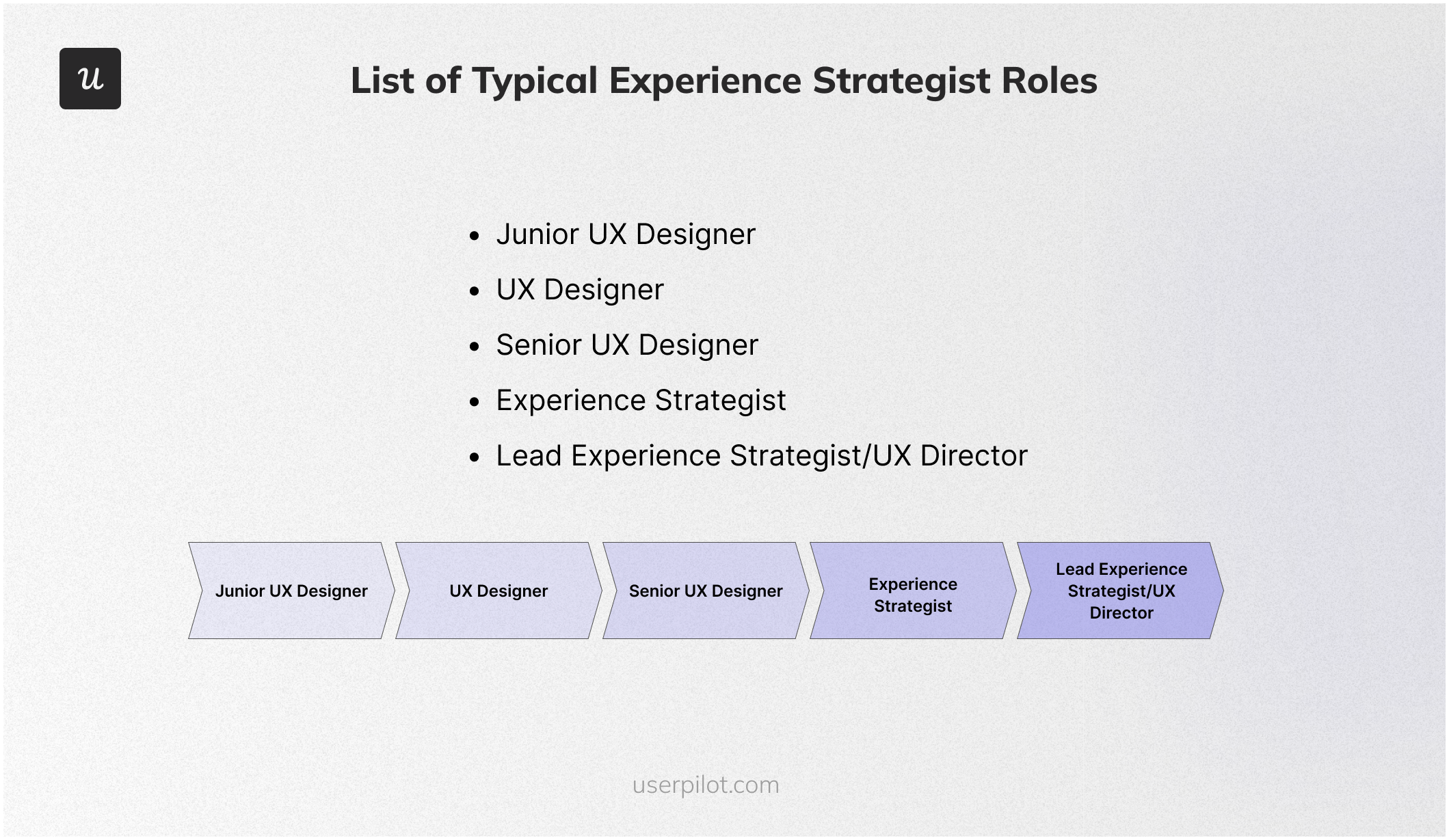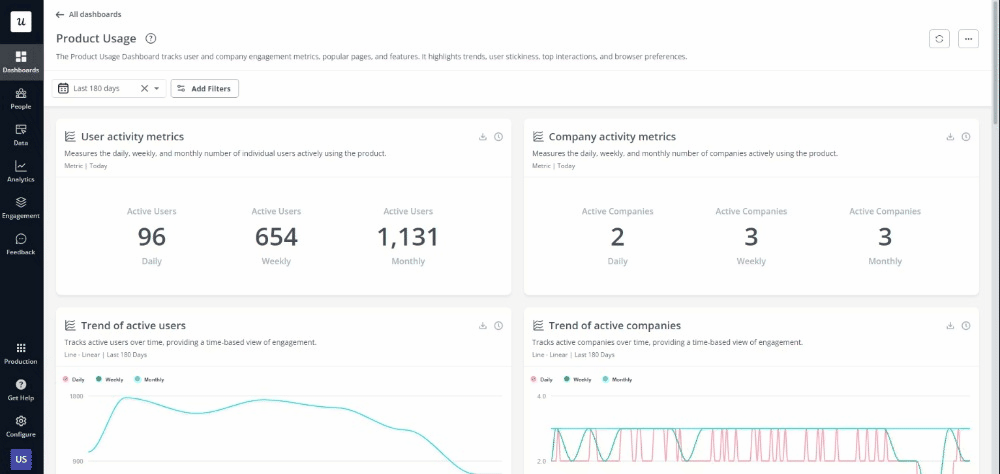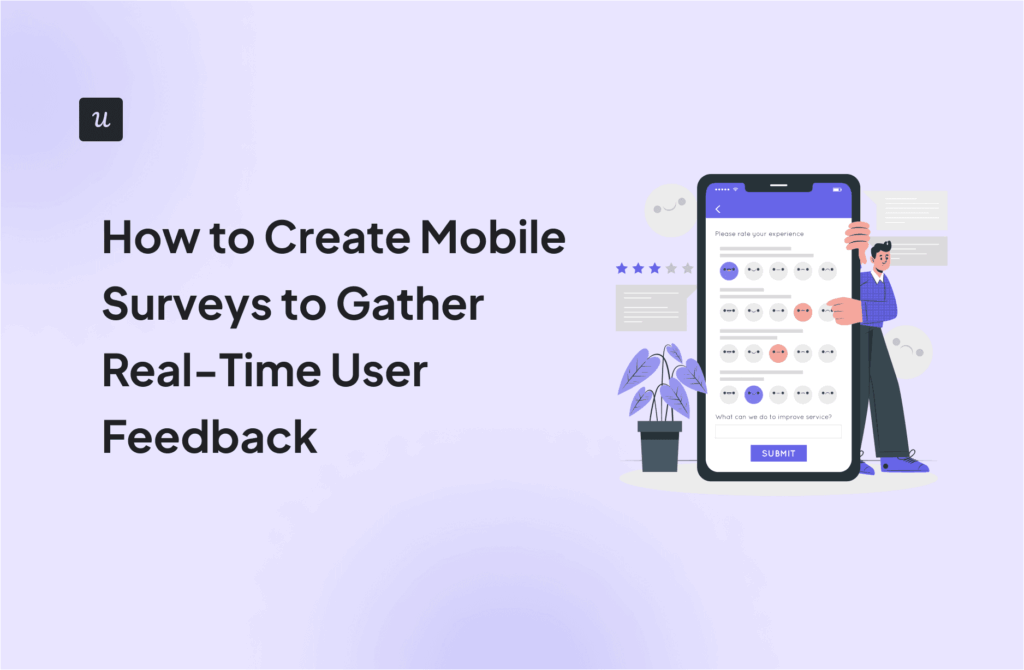![How to Become an Experience Strategist [+Tools and Resources]](https://blog-static.userpilot.com/blog/wp-content/uploads/2024/07/How-to-Become-an-Experience-Strategist-Tools-and-Resources.png)
Try Userpilot Now
See Why 1,000+ Teams Choose Userpilot

How to become an experience strategist?
- An experience strategist designs and optimizes user experiences across different touchpoints to enhance customer satisfaction and engagement.
- They combine insights from user research, data analytics, and design thinking to create cohesive and compelling experiences that align with business goals.
- An experience strategist’s career path typically involves a progression through various roles, each with increasing responsibility and complexity. Here are five key positions along this career path:
- Junior UX Designer
- UX Designer
- Senior UX Designer
- Experience Strategist
- Lead Experience Strategist/UX Director
- To become an experience strategist, start by pursuing a relevant educational background, such as a bachelor’s degree in design, psychology, marketing, or a related field. Supplement your education with courses in user experience (UX) design, research methodologies, and data analysis.
- Experience strategists can utilize a range of tools to enhance their work. Userpilot assists in user onboarding, while Monday and Jira Software streamline project and product management, etc.
- Looking into tools for experience strategists? Userpilot is an all-in-one product platform with engagement features and powerful analytics capabilities. Book a demo to see it in action!
Experience strategist’s main responsibilities
An experience strategist plays a crucial role in designing and optimizing user experiences to enhance customer satisfaction and engagement. Their responsibilities encompass a variety of tasks aimed at improving user interactions and ensuring a seamless experience across all touchpoints.
- Conduct user research: Gather insights into user needs, behaviors, and pain points through interviews, surveys, and usability testing to inform design decisions.
- Develop user personas: Create detailed user personas based on research to better understand target audiences and tailor experiences to meet their needs.
- Create user journey maps: Visualize the user journey across different touchpoints to identify areas for improvement and ensure a cohesive experience.
- Collaborate with cross-functional teams: Work closely with design, product, marketing, and engineering teams to align strategies and ensure a unified approach to user experience.
- Design wireframes and prototypes: Develop wireframes and interactive prototypes to test and iterate on design concepts before implementation.
- Optimize onboarding processes: Design and refine user onboarding experiences to ensure new users can easily understand and adopt the product.
- Analyze user data: Use data analytics tools to track user behavior and measure the effectiveness of implemented strategies, making data-driven decisions.
- Stay updated with industry trends: Continuously educate yourself on the latest trends, tools, and best practices in UX and experience strategy.
- Conduct A/B testing: Perform A/B tests to compare different design elements and identify the most effective solutions for enhancing user experience.
- Present findings and recommendations: Communicate insights and strategic recommendations to stakeholders, ensuring alignment and buy-in for proposed changes.
Experience strategist career path
An experience strategist’s career path typically involves a progression through various roles, each with increasing responsibility and complexity. Here are five key positions along this career path:

- Junior UX Designer: Entry-level role focused on creating user interfaces and experiences. Responsibilities include assisting with user research, wireframing, prototyping, and collaborating with senior designers to implement feedback.
- UX Designer: Mid-level position responsible for conducting user research, developing user personas, creating detailed wireframes and prototypes, and collaborating with cross-functional teams to design and improve user experiences.
- Senior UX Designer: Advanced role with a focus on leading design projects, mentoring junior designers, conducting complex user research, and developing comprehensive user experience strategies. Responsible for ensuring design consistency and quality across projects.
- Experience Strategist: Role focused on developing and implementing strategies to enhance overall user experiences across all touchpoints. Responsibilities include conducting extensive user research, creating journey maps, and collaborating with various departments.
- Lead Experience Strategist/UX Director: Senior leadership position overseeing the entire UX strategy and team. Responsibilities include defining the user experience vision, leading large-scale projects, managing a team of designers and strategists, and ensuring that all user experience efforts align with the company’s strategic goals.
How to become an experience strategist?
To become an experience strategist, start by pursuing a relevant educational background, such as a bachelor’s degree in design, psychology, marketing, or a related field. Supplement your education with courses in user experience (UX) design, research methodologies, and data analysis.
Gaining practical experience through internships or entry-level positions in UX design, digital marketing, or product management is crucial. These roles will help you develop a deep understanding of user behavior and design principles.
Additionally, building a portfolio showcasing your ability to create effective user experiences can significantly enhance your job prospects.
Networking with professionals in the field and staying updated with industry trends through workshops, conferences, and online communities will further support your journey to becoming a successful experience strategist.
What skills should an experience strategist have?
An experience strategist possesses a unique blend of skills that enable them to design and optimize user experiences effectively. These skills encompass research, analysis, creativity, and collaboration, allowing them to craft compelling and cohesive experiences.
Here are some skills required:
- User research: Ability to gather and interpret data on user needs, behaviors, and pain points through various research methods.
- Data analysis: Proficiency in analyzing quantitative and qualitative data to inform experience strategies and measure their impact.
- Design thinking: Application of design thinking principles to solve problems creatively and innovatively.
- Journey mapping: Expertise in creating detailed user journey maps to visualize and improve the customer experience.
- Collaboration: Strong teamwork skills, working closely with design, marketing, product, and engineering teams to align strategies.
- Communication: Excellent verbal and written communication skills to present insights and recommendations effectively.
- Project management: Ability to manage multiple projects and deadlines, ensuring timely delivery of experience improvements.
- Strategic thinking: Capability to think strategically about the overall user experience and its alignment with business goals.
- Customer empathy: A deep understanding of and empathy for users, ensuring that their needs and perspectives are central to all design decisions.
Best certifications for experience strategists
While there’s no single “best” certification for experience strategists, several highly-regarded programs and courses can boost your skills and credibility. Here are a few options for you:
- Hyper Island – Digital Experience Design: This program covers various aspects of experience design, including strategy, research, and implementation.
- Kent State University – User Experience Design Master’s Degree: This program specializes in experience strategy and research.
- General Assembly – User Experience Design Immersive: This boot camp covers UX fundamentals and delves into experience strategy and research methodologies.
- Nielsen Norman Group – UX Certification: While not solely focused on experience strategy, this certification covers essential UX principles and research methodologies relevant to strategists.
- Udemy – Experience Strategy Courses: Udemy offers various courses on experience strategy, customer journey mapping, and service design.
- Coursera – Design Thinking for Innovation: This specialization by the University of Virginia covers design thinking principles and methodologies crucial for experience strategists.
Best resources for experience strategists
To excel as an experience strategist, it’s essential to stay updated with the latest trends and best practices in the field. Here are some of the best resources, including books, webinars, podcasts, and blogs, that can help you enhance your knowledge and skills.
Best books for experience strategists
Here are the best books we recommend for experience strategists.
- Don’t Make Me Think by Steve Krug: A classic book on web usability that provides practical advice on creating intuitive user interfaces.
- The Design of Everyday Things by Don Norman: This book explores the principles of good design and how they can be applied to create better user experiences.
- Lean UX by Jeff Gothelf and Josh Seiden: A guide to integrating lean principles into UX design for faster, more effective product development.
- UX Strategy by Jaime Levy: This book offers a step-by-step guide to creating innovative product strategies that align with user needs.
- Designing for Interaction by Dan Saffer: A comprehensive guide to the principles and techniques of interaction design.
Best webinars for experience strategists
Here are the best webinars we recommend for experience strategists.
- Userpilot Webinars: Userpilot offers a range of webinars on user onboarding, product adoption, and user experience strategies.
- NNG UX Webinars: Nielsen Norman Group provides webinars on various UX topics conducted by industry experts.
- UXPin Webinars: These webinars cover UX design, research, and collaboration best practices.
- Interaction Design Foundation Webinars: IDF offers webinars on a wide range of UX and design-related topics.
- Smashing Magazine Webinars: These webinars provide insights into the latest trends and techniques in web design and development.
Best blogs for experience strategists
Here are the best blogs we recommend for experience strategists.
- Userpilot Blog: Insights and articles on user onboarding, product adoption, and user experience strategies.
- Nielsen Norman Group Blog: Research-based articles on usability, UX design, and user research.
- Smashing Magazine: A blog that covers the latest in web design, UX, and front-end development.
- UX Planet: A comprehensive blog that offers articles on UX design, research, and career advice.
- UX Design.cc: A curated collection of articles and resources on UX design and strategy.
Best podcasts for experience strategists
Here are the best podcasts we recommend for experience strategists.
- Product Heros by Userpilot: Userpilot’s podcast features interviews with industry experts on user experience and product growth strategies.
- UI Breakfast: A podcast on UI/UX design, product strategy, and marketing, featuring expert interviews and actionable insights.
- The NN/g UX Podcast: Hosted by the Nielsen Norman Group, this podcast covers various aspects of user experience design and research.
- Awkward Silences: A podcast about UX research, where hosts talk to industry experts about their experiences and methodologies.
- Design Better Podcast: InVision’s podcast explores how the world’s best designers create better products, companies, and experiences.
Best tools for experience strategists
To excel in creating seamless and engaging user experiences, an experience strategist needs a diverse set of tools. Here are some of the best tools for various aspects of experience strategy:
- Best tool for user onboarding – Userpilot: Userpilot is a powerful tool for creating personalized user onboarding experiences, helping users get the most out of your product from day one.
- Best tool for project management – Monday: Monday is an intuitive project management tool that helps teams collaborate effectively, track progress, and manage tasks efficiently.
- Best tool for product management – Jira Software: Jira Software is a robust product management tool designed for agile teams, offering comprehensive features for planning, tracking, and releasing software.
- Best tool for CX management – Zendesk: Zendesk is a leading customer experience tool that provides a suite of support apps to improve customer relationships and satisfaction.
- Best tool for customer success – ClientSuccess: ClientSuccess offers a comprehensive platform to manage customer success processes, helping to reduce churn and increase customer satisfaction.
- Best tool for UX/UI design – Figma: Figma is a cloud-based design tool that allows teams to collaborate in real-time on creating and refining user interfaces and experiences.
- Best tool for data visualization – Tableau: Tableau is a powerful data analytics tool that helps experience strategists visualize and understand complex data to make informed decisions.
- Best tool for collaboration and documentation – Confluence: Confluence by Atlassian is a collaboration tool that helps teams create, share, and manage documentation and knowledge bases effectively.
- Best tool for customer feedback – HubSpot Service: HubSpot Service is an all-in-one customer service tool that helps collect and analyze customer feedback to improve the overall user experience.
- Best tool for agile project management – Trello: Trello is a flexible project management tool that uses boards, lists, and cards to help teams manage tasks and projects in an agile environment.
Experience strategist FAQs
- What is the role of an experience strategist? An experience strategist designs and optimizes user experiences across different touchpoints to enhance customer satisfaction and engagement.
- What is an experience strategy? An experience strategy is a plan that aligns business goals with user needs, using research and data to create cohesive and compelling user experiences.
- What is a user experience strategist? A user experience strategist focuses on creating and improving user interactions with a product or service, ensuring a seamless and satisfying experience for users.
- What is the work of a strategist? The work of a strategist involves researching, planning, and implementing strategies to achieve specific goals, often by analyzing data and collaborating with various teams to ensure alignment and effectiveness.
Conclusion
Becoming a successful experience strategist requires dedication, continuous learning, and a proactive approach to developing relevant skills.
By following the outlined steps and leveraging the resources available, you can effectively navigate your career path and achieve your professional goals.
We hope this guide has provided you with valuable insights and practical advice to help you on your journey to becoming a proficient and impactful experience strategist!
Looking into tools for experience strategists? Userpilot is an all-in-one product platform with engagement features and powerful analytics capabilities. Book a demo to see it in action!








